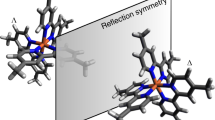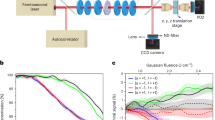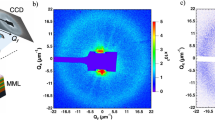Abstract
Magneto-chiral dichroism is a non-reciprocal—that is, directional—effect observed in magnetized chiral systems, featuring an unbalanced absorption of unpolarized light depending on the direction of the magnetization. Despite the fundamental interest in a phenomenon breaking both parity and time-reversal symmetries, magneto-chiral dichroism is one of the least investigated aspects of light–matter interaction most likely because of the weakness of the effect in most reported experiments. Here we have exploited the element selectivity of hard X-ray radiation to investigate the magneto-chiral properties of enantiopure crystals of two isostructural molecular helicoidal chains comprising either cobalt(II) or manganese(II) ions. A strong magneto-chiral dichroism, with Kuhn asymmetry of the order of a few per cent, has been observed in the cobalt chains system, whereas it is practically absent for the manganese derivative. The spectral features of the X-ray magneto-chiral dichroism signal differ significantly from the natural and magnetic dichroic contributions and have been rationalized here using the multipolar expansion of matter–radiation interaction.
This is a preview of subscription content, access via your institution
Access options
Subscribe to this journal
Receive 12 print issues and online access
$209.00 per year
only $17.42 per issue
Buy this article
- Purchase on Springer Link
- Instant access to full article PDF
Prices may be subject to local taxes which are calculated during checkout




Similar content being viewed by others
References
Pasteur, L. La dissymétrie moléculaire. Conférence faite le 22 décembre 1883. Rev. Sci. 7, 2–6 (1884).
Bordacs, S. et al. Chirality of matter shows up via spin excitations. Nature Phys. 8, 734–738 (2012).
Mühlbauer, S. et al. Skyrmion lattice in a chiral magnet. Science 323, 915–919 (2009).
Fert, A., Cros, V. & Sampaio, J. Skyrmions on the track. Nature Nanotech. 8, 152–156 (2013).
Romming, N. et al. Writing and deleting single magnetic skyrmions. Science 341, 636–639 (2013).
Pop, F., Auban-Senzier, P., Canadell, E., Rikken, G. L. J. A. & Avarvari, N. Electrical magnetochiral anisotropy in a bulk chiral molecular conductor. Nature Commun. 5, 3757 (2014).
Wagnière, G. & Meier, A. The influence of a static magnetic field on the absorption coefficient of a chiral molecule. Chem. Phys. Lett. 93, 78–81 (1982).
Groenewege, M. P. A theory of magneto-optical rotation in diamagnetic molecules of low symmetry. Mol. Phys. 5, 541–563 (1962).
Barron, L. D. & Vrbancich, J. Magneto-chiral birefringence and dichroism. Mol. Phys. 51, 715–730 (1984).
Baranova, N. B., Bogdanov, Y. V. & Zel’Dovich, B. Y. Electrical analog of the Faraday effect and other new optical effects in liquids. Opt. Commun. 22, 243–247 (1977).
Rikken, G. & Raupach, E. Observation of magneto-chiral dichroism. Nature 390, 493–494 (1997).
Goulon, J. et al. X-ray magnetochiral dichroism: A new spectroscopic probe of parity nonconserving magnetic solids. Phys. Rev. Lett. 88, 237401 (2002).
Wagnière, G. H. On Chiralty and the Universal Asymmetry (Verlag Helvetica Chimica Acta, 2007).
Guijarro, A. & Yus, M. The Origin of Chirality in the Molecules of Life (Royal Society of Chemistry, 2009).
Rikken, G. L. J. A. & Raupach, E. Enantioselective magnetochiral photochemistry. Nature 405, 932–935 (2000).
Zel’dovich, Y. B. Electromagnetic interaction with parity violation. Sov. Phys. JETP 6, 1184–1186 (1958).
Vallet, M. et al. Observation of magnetochiral birefringence. Phys. Rev. Lett. 87, 183003 (2001).
Kubota, M. et al. X-ray directional dichroism of a polar ferrimagnet. Phys. Rev. Lett. 92, 137401 (2004).
Train, C. et al. Strong magneto-chiral dichroism in enantiopure chiral ferromagnets. Nature Mater. 7, 729–734 (2008).
Kitagawa, Y., Segawa, H. & Ishii, K. Magneto-chiral dichroism of organic compounds. Angew. Chem. Int. Ed. 50, 9133–9136 (2011).
Ceolín, M., Goberna-Ferrón, S. & Galán-Mascarós, J. R. Strong hard X-ray magnetochiral dichroism in paramagnetic enantiopure molecules. Adv. Mater. 24, 3120–3123 (2012).
Cheong, S-W. & Mostovoy, M. Multiferroics: A magnetic twist for ferroelectricity. Nature Mater. 6, 13–20 (2007).
Khomskii, D. Classifying multiferroics: Mechanisms and effects. Physics 2, 20 (2009).
Caneschi, A., Gatteschi, D., Rey, P. & Sessoli, R. Structure and magnetic-ordering of a ferrimagnetic helix formed by manganese(II) and a nitronyl nitroxide radical. Inorg. Chem. 30, 3936–3941 (1991).
Caneschi, A. et al. Cobalt(II)-nitronyl nitroxide chains as molecular magnetic nanowires. Angew. Chem. Int. Ed. 40, 1760–1763 (2001).
Cavigli, L., Sessoli, R., Gurioli, M. & Bogani, L. Second harmonic generation in a molecular magnetic chain. Phys. Status Solidi A 203, 1402–1408 (2006).
Heintze, E. et al. Dynamic control of magnetic nanowires by light-induced domain-wall kickoffs. Nature Mater. 12, 202–206 (2013).
Glauber, R. J. Time-dependent statistic of the Ising model. J. Math. Phys. 4, 294–307 (1963).
Bogani, L. et al. Finite-size effects in single chain magnets: An experimental and theoretical study. Phys. Rev. Lett. 92, 207204 (2004).
Goulon, J. et al. X-ray optical activity: Applications of sum rules. JETP 97, 402–431 (2003).
Spaldin, N. A., Fiebig, M. & Mostovoy, M. The toroidal moment in condensed-matter physics and its relation to the magnetoelectric effect. J. Phys. Condens. Matter 20, 434203 (2008).
Szaller, D., Bordács, S. & Kézsmárki, I. Symmetry conditions for nonreciprocal light propagation in magnetic crystals. Phys. Rev. B 87, 014421 (2013).
Alagna, L. et al. X-ray natural circular dichroism. Phys. Rev. Lett. 80, 4799–4802 (1998).
Goulon, J., Rogalev, A. & Brouder, C. Comprehensive Chiroptical Spectroscopy 457–491 (John Wiley, 2012).
Stewart, B. et al. Circular dichroism at the edge: Large X-ray natural CD in the 1s → 3d pre-edge feature of 2[Co(en)3Cl3] ⋅ NaCl ⋅ 6H2O. J. Am. Chem. Soc. 121, 10233–10234 (1999).
Bunău, O. & Joly, Y. Self-consistent aspects of x-ray absorption calculations. J. Phys. Condens. Matter 21, 345501 (2009).
Kitagawa, Y., Miyatake, T. & Ishii, K. Magneto-chiral dichroism of artificial light-harvesting antenna. Chem. Commun. 48, 5091–5093 (2012).
Rikken, G. & Raupach, E. Pure and cascaded magnetochiral anisotropy in optical absorption. Phys. Rev. E 58, 5081–5084 (1998).
Caneschi, A., Gatteschi, D., Lalioti, N., Sangregorio, C. & Sessoli, R. Supramolecular interactions and magnetism of metal-radical chains. J. Chem. Soc. Dalton Trans. 3907–3912 (2000).
Kibayashi, S., Takahashi, Y., Seki, S. & Tokura, Y. Magnetochiral dichroism resonant with electromagnons in a helimagnet. Nature Commun. 5, 4583 (2014).
Carra, P., Jerez, A. & Marri, I. X-ray dichroism in noncentrosymmetric crystals. Phys. Rev. B 67, 045111 (2003).
Lovesey, S. W. & Balcar, E. Quantum theory of natural circular, magneto-chiral and non-reciprocal linear dichroism. Phys. Scr. 81, 065703 (2010).
Scagnoli, V. et al. Observation of orbital currents in CuO. Science 332, 696–698 (2011).
Wagnière, G. Inverse magnetochiral birefringence. Phys. Rev. A 40, 2437–2440 (1989).
Rogalev, A., Goulon, J., Goulon-Ginet, C. & Malgrange, C. in Magnetism and Synchrotron Radiation: Lecture Notes in Physics (eds Beaurepaire, E., Scheurer, F., Krill, G. & Kappler, J. P.) 61 (Springer, 2001).
Caneschi, A., Gatteschi, D., Rey, P. & Sessoli, R. Structure and magnetic-properties of ferrimagnetic chains formed by manganese(II) and nitronyl nitroxides. Inorg. Chem. 27, 1756–1761 (1988).
Acknowledgements
We acknowledge the financial contribution of the European Research Council through the AdG MolNanoMaS (267746). The support of ESRF through beamtime allocation (projects HE-3896 and HC-972) is acknowledged. We are indebted to Y. Joly for assistance in spectra simulation and to R. Caciuffo, Ph. Sainctavit and J. Villain for stimulating discussions.
Author information
Authors and Affiliations
Contributions
R.S. and A.R. designed the experiment. A.C. synthesized the materials and grew the crystals. M-E.B. carried out preliminary crystallographic and magnetic analysis. M-E.B., M.M., L.P., R.S., F.W. and A.R. participated in the synchrotron experiments and analysed the data. F.W. simulated the XANES and XNCD spectra. R.S. and A.R. wrote the manuscript with contributions from all authors.
Corresponding author
Ethics declarations
Competing interests
The authors declare no competing financial interests.
Supplementary information
Supplementary Information
Supplementary Information (PDF 743 kb)
Rights and permissions
About this article
Cite this article
Sessoli, R., Boulon, ME., Caneschi, A. et al. Strong magneto-chiral dichroism in a paramagnetic molecular helix observed by hard X-rays. Nature Phys 11, 69–74 (2015). https://doi.org/10.1038/nphys3152
Received:
Accepted:
Published:
Issue Date:
DOI: https://doi.org/10.1038/nphys3152
This article is cited by
-
Nonreciprocal directional dichroism at telecom wavelengths
npj Quantum Materials (2022)
-
Dielectric magnetochiral anisotropy
Nature Communications (2022)
-
Nonreciprocal directional dichroism of a chiral magnet in the visible range
npj Quantum Materials (2020)
-
Molecular magnetism: from chemical design to spin control in molecules, materials and devices
Nature Reviews Materials (2019)
-
Electric field modulation of magnetic exchange in molecular helices
Nature Materials (2019)



